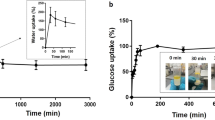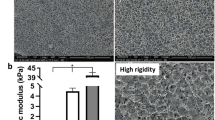Abstract
Articular cartilage is an avascular connective tissue responsible for bearing loads. Cell signaling plays a central role in cartilage homeostasis and tissue engineering by directing chondrocytes to synthesize/degrade the extracellular matrix or promote inflammatory responses. The aim of this paper was to investigate anabolic, catabolic and inflammatory pathways of well-known and underreported anabolic stimuli in 3D chondrocyte cultures and connect them to diverse cartilage responses including matrix regeneration and cell communication. A cue-signal-response experiment was performed in chondrocytes embedded in alginate scaffolds subjected to a 9-day treatment with 7 anabolic cues. At the signaling level diverse pathways were measured whereas at the response level glycosaminoglycan (GAG) synthesis and cytokine releases were monitored. A significant increase of GAG was observed for each stimulus and well known anabolic phosphoproteins were activated. In addition, WNK1, an underreported protein of chondrocyte signaling, was uncovered. At the extracellular level, inflammatory and regulating cytokines were measured and DEFB1 and CXCL10 were identified as novel contributors to chondrocyte responses, both closely linked to TLR signaling and inflammation. Finally, two new pro-growth factors with an inflammatory potential, Cadherin-11 and MGP were observed. Interestingly, well-known anabolic stimuli yielded inflammatory responses which pinpoints to the pleiotropic roles of individual stimuli.





Similar content being viewed by others
Change history
06 May 2019
This erratum is to add the following paragraph in the Acknowledgement section:
06 May 2019
This erratum is to add the following paragraph in the Acknowledgement section:
References
Alexopoulos, L. G., J. Saez-Rodriguez, and C. W. Espelin. High throughput protein-based technologies and computational models for drug development, efficacy and toxicity. Drug Efficacy, Safety, and Biologics Dis-covery: Emerging Technologies and Tools: Wiley, pp. 29–52, 2009.
Aupperle, K. R., B. L. Bennett, D. L. Boyle, P.-P. Tak, A. M. Manning, and G. S. Firestein. Nf-κb regulation by iκb kinase in primary fibroblast-like synoviocytes. J. Immunol. 163(1):427–433, 1999.
Barabas, N., J. Röhrl, E. Holler, and T. Hehlgans. Beta-defensins activate macrophages and synergize in pro-inflammatory cytokine expression induced by tlr ligands. Immunobiology 218(7):1005–1011, 2013.
Beachley, V. Z., M. T. Wolf, K. Sadtler, S. S. Manda, H. Jacobs, M. Blatchley, J. S. Bader, A. Pandey, D. Pardoll, and J. H. Elisseeff. Tissue matrix arrays for high throughput screening and systems analysis of cell function. Nat. Methods 12(12):1197, 2015.
Buckwalter, J., and H. Mankin. Articular cartilage: tissue design and chondrocyte-matrix interactions. Instr. Course Lect. 47:477–486, 1997.
Calamia, V., L. Lourido, P. Fernández-Puente, J. Mateos, B. Rocha, E. Montell, J. Vergés, C. Ruiz-Romero, and F. J. Blanco. Secretome analysis of chondroitin sulfate-treated chondrocytes reveals anti-angiogenic, anti-inflammatory and anti-catabolic properties. Arthr. Res. Ther. 14(5):R202, 2012.
Chakraborti, S., M. Mandal, S. Das, A. Mandal, and T. Chakraborti. Regulation of matrix metalloproteinases: an overview. Mol. Cell. Biochem. 253(1–2):269–285, 2003.
Chapman, J. R., O. Katsara, R. Ruoff, D. Morgenstern, S. Nayak, C. Basilico, B. Ueberheide, and V. Kolupaeva. Phosphoproteomics of fibroblast growth factor 1 (fgf1) signaling in chondrocytes: identifying the signature of inhibitory response. Mol. Cell. Proteom. 16(6):1126–1137, 2017.
Danišovic, L., I. Varga, and Š. Polák. Growth factors and chondrogenic differentiation of mesenchymal stem cells. Tissue Cell 44(2):69–73, 2012.
Ding, X., Y. Zhang, Y. Huang, S. Liu, H. Lu, and T. Sun. Cadherin-11 involves in synovitis and increases the migratory and invasive capacity of fibroblast-like synoviocytes of osteoarthritis. Int. Immunopharmacol. 26(1):153–161, 2015.
Enobakhare, B. O., D. L. Bader, and D. A. Lee. Quantification of sulfated glycosaminoglycans in chondrocyte/alginate cultures, by use of 1, 9-dimethylmethylene blue. Anal. Biochem. 243(1):189–191, 1996.
Goldring, M. B. Osteoarthritis and cartilage: the role of cytokines. Curr. Rheumatol. Rep. 2(6):459–465, 2000.
Gómez, R., A. Villalvilla, R. Largo, O. Gualillo, and G. Herrero-Beaumont. Tlr4 signalling in osteoarthritis [mdash] finding targets for candidate dmoads. Nat. Rev. Rheumatol. 11(3):159–170, 2015.
Haglund, L., S. M. Bernier, P. Önnerfjord, and A. D. Recklies. Proteomic analysis of the lps-induced stress response in rat chondrocytes reveals induction of innate immune response components in articular cartilage. Matrix Biol. 27(2):107–118, 2008.
Hashimoto, S., T. Nishiyama, S. Hayashi, T. Fujishiro, K. Takebe, N. Kanzaki, R. Kuroda, and M. Kurosaka. Role of p53 in human chondrocyte apoptosis in response to shear strain. Arthr. Rheum. 60(8):2340–2349, 2009.
Hsueh, M.-F., P. Önnerfjord, and V. B. Kraus. Biomarkers and proteomic analysis of osteoarthritis. Matrix Biol. 39:56–66, 2014.
Janes, K. A., J. R. Kelly, S. Gaudet, J. G. Albeck, P. K. Sorger, and D. A. Lauffenburger. Cue-signal-response analysis of tnf-induced apoptosis by partial least squares regression of dynamic multivariate data. J. Comput. Biol. 11(4):544–561, 2004.
Johnson, C. I., D. J. Argyle, and D. N. Clements. In vitro models for the study of osteoarthritis. Vet. J. 209:40–49, 2016.
Lindsley, H. B., D. D. Smith, C. B. Cohick, A. E. Koch, and L. S. Davis. Proinflammatory cytokines enhance human synoviocyte expression of functional intercellular adhesion molecule-1 (icam-1). Clin. Immunol. Immunopathol. 68(3):311–320, 1993.
Long, F., E. Schipani, H. Asahara, H. Kronenberg, and M. Montminy. The creb family of activators is required for endochondral bone development. Development 128(4):541–550, 2001.
Mannell, H., and F. Krotz. Shp-2 regulates growth factor dependent vascular signalling and function. Mini Rev. Med. Chem. 14(6):471–483, 2014.
Mariani, E., L. Pulsatelli, and A. Facchini. Signaling pathways in cartilage repair. Int. J. Mol. Sci. 15(5):8667–8698, 2014.
McCormick, J. A., and D. H. Ellison. The wnks: atypical protein kinases with pleiotropic actions. Physiol. Rev. 91(1):177–219, 2011.
Melas, I. N., A. D. Chairakaki, E. I. Chatzopoulou, D. E. Messinis, T. Katopodi, V. Pliaka, S. Samara, A. Mitsos, Z. Dailiana, P. Kollia, et al. Modeling of signaling pathways in chondrocytes based on phosphoproteomic and cytokine release data. Osteoarthr. Cartil. 22(3):509–518, 2014.
Misra, D., S. L. Booth, M. D. Crosier, J. M. Ordovas, D. T. Felson, and T. Neogi. Matrix gla protein polymorphism, but not concentrations, is associated with radiographic hand osteoarthritis. J. Rheumatol. 38(9):1960–1965, 2011.
Na, K., S. Kim, D. G. Woo, B. K. Sun, H. N. Yang, H.-M. Chung, and K.-H. Park. Combination material delivery of dexamethasone and growth factor in hydrogel blended with hyaluronic acid constructs for neocartilage formation. Biomed. Mater. Res. Part A 83(3):779–786, 2007.
Polacek, M., J.-A. Bruun, O. Johansen, and I. Martinez. Comparative analyses of the secretome from dedifferentiated and redifferentiated adult articular chondrocytes. Cartilage 2(2):186–196, 2011.
Proost, P., A.-K. Vynckier, F. Mahieu, W. Put, B. Grillet, S. Struyf, A. Wuyts, G. Opdenakker, and J. V. Damme. Microbial toll-like receptor ligands differentially regulate cxcl10/ip-10 expression in fibroblasts and mononuclear leukocytes in synergy with ifn-γ and provide a mechanism for enhanced synovial chemokine levels in septic arthritis. Eur. J. Immunol. 33(11):3146–3153, 2003.
Saez-Rodriguez, J., L. G. Alexopoulos, J. Epperlein, R. Samaga, D. A. Lauffenburger, S. Klamt, and P. K. Sorger. Discrete logic modelling as a means to link protein signalling networks with functional analysis of mammalian signal transduction. Mol. Syst. Biol. 5(1):331, 2009.
Scarf, S. Use of bone morphogenetic proteins in mesenchymal stem cell stimulation of cartilage and bone repair. World J. Stem Cells 8(1):1, 2016.
Sillat, T., G. Barreto, P. Clarijs, A. Soininen, M. Ainola, J. Pajarinen, M. Korhonen, Y. T. Konttinen, R. Sakalyte, M. Hukkanen, et al. Toll-like receptors in human chondrocytes and osteoarthritic cartilage. Acta Orthop. 84(6):585–592, 2013.
Stanton, L.-A., T. M. Underhill, and F. Beier. Map kinases in chondrocyte differentiation. Dev. Biol. 263(2):165–175, 2003.
Tigli, R. S., and M. Gümüsderelioglu. Evaluation of rgd-or egf-immobilized chitosan scaffolds for chondrogenic activity. Int. J. Biol. Macromol. 43(2):121–128, 2008.
Veilleux, N., and M. Spector. Effects of fgf-2 and igf-1 on adult canine articular chondrocytes in type ii collagen–glycosaminoglycan scaffolds in vitro. Osteoarthr. Cartil. 13(4):278–286, 2005.
Verzijl, N., J. DeGroot, S. R. Thorpe, R. A. Bank, J. N. Shaw, T. J. Lyons, J. W. Bijlsma, F. P. Lafeber, J. W. Baynes, and J. M. TeKoppele. Effect of collagen turnover on the accumulation of advanced glycation end products. J. Biol. Chem. 275(50):39027–39031, 2000.
Wuyts, V., N. H. Roosens, S. Bertrand, K. Marchal, and S. C. De Keersmaecker. Guidelines for optimisation of a multiplex oligonucleotide ligation-pcr for characterisation of microbial pathogens in a microsphere suspension array. BioMed research international, 2015.
Conflict of interest
None of the authors have any financial interest to disclose.
Author information
Authors and Affiliations
Corresponding author
Additional information
Associate Editor Michael S. Detamore oversaw the review of this article.
Electronic supplementary material
Below is the link to the electronic supplementary material.
Rights and permissions
About this article
Cite this article
Neidlin, M., Korcari, A., Macheras, G. et al. Cue-Signal-Response Analysis in 3D Chondrocyte Scaffolds with Anabolic Stimuli. Ann Biomed Eng 46, 345–353 (2018). https://doi.org/10.1007/s10439-017-1964-8
Received:
Accepted:
Published:
Issue Date:
DOI: https://doi.org/10.1007/s10439-017-1964-8




